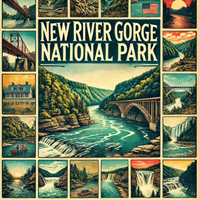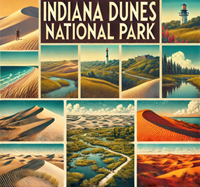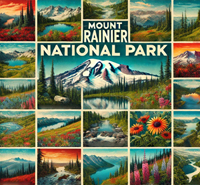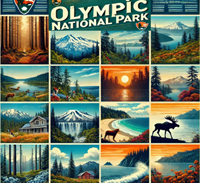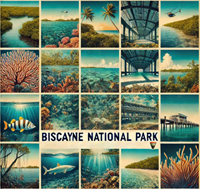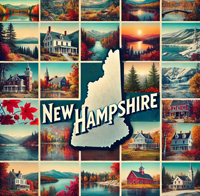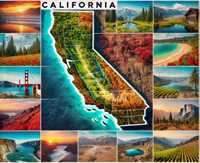

William and Hui Cha Stanek have meticulously crafted these national park guides, each showcasing the most stunning landscapes across the USA. But beyond the breathtaking scenery, these guides delve into the stories, experiences, and connections that make each park visit truly memorable.
National Parks Index | US Itineraries Index | American Roadtrips Index

Bring home a Bugville Critters book and watch as your child's love for reading and learning grows with every page. Hand-painted illustrations bring the heartwarming stories to life. Ask your librarian to add Bugville Critters to the library's digital collection today!
Discover William Stanek's Exclusive Art Collection
Explore and purchase the stunning art featured on this site. Own a piece of William Stanek's unique and captivating artwork today!
(May 2, 2025) Introducing Gates of the Arctic National Park and Preserve: Alaska's Pristine Wilderness
Introduction to Gates of the Arctic National Park and Preserve
Gates of the Arctic National Park is the epitome of untouched wilderness, a vast and remote expanse where the beauty of nature is raw and unfiltered. This park is not for the faint of heart-- it' s a place where there are no roads, no trails, and no signs of human development. My visit to Gates of the Arctic was an adventure in its purest form, requiring careful planning and a deep respect for the land. I remember flying over the Brooks Range, seeing the rugged peaks and endless valleys stretching out beneath us, untouched by time. Camping under the midnight sun, surrounded by the pristine beauty of the Arctic, was a humbling experience that reminded me of the power and fragility of our natural world. Gates of the Arctic is a place that stays with you, a true wilderness where nature' s forces are on full display.
How to Reach Gates of the Arctic National Park and Preserve
From the North (Fairbanks, AK): Travelers can fly from Fairbanks to Bettles or Anaktuvuk Pass, then charter a small plane to access the park. There are no roads leading to the park, so access is typically by air.
From the South (Anchorage, AK): Visitors from Anchorage can fly to Fairbanks, then take a flight to Bettles or Anaktuvuk Pass and charter a plane to the park. This journey covers approximately 700 miles by air.
From the East (Barrow, AK): Travelers from Barrow can fly to Fairbanks, then follow the route from Fairbanks to the park. This route covers approximately 500 miles by air.
From the West (Kotzebue, AK): From Kotzebue, travelers can fly to Fairbanks, then follow the route from Fairbanks to the park. This journey spans around 600 miles by air.
Exploring Gates of the Arctic: Must-Visit Sites
- Arrigetch Peaks: A group of rugged granite spires offering challenging climbs and stunning views.
- Koyukuk River: A major river providing opportunities for rafting and wildlife viewing.
- Anaktuvuk Pass: A remote village offering insights into the region's indigenous culture.
- Brooks Range: A majestic mountain range offering unparalleled wilderness experiences.
Seasonal Variations
Gates of the Arctic's remote location offers beauty in all seasons:
- Spring: Melting snow and ice create opportunities for wildlife viewing and early season hiking.
- Summer: Long daylight hours and milder temperatures make for ideal conditions for exploration and mountaineering.
- Fall: The brief autumn season offers vibrant fall colors and the caribou migration.
- Winter: Extreme cold and snow provide a stark and beautiful landscape, ideal for those seeking solitude and winter sports.
Visitor Updates for Gates of the Arctic National Park and Preserve
Conservation Efforts
William Stanek's photography in Gates of the Arctic emphasizes the park's vast and pristine wilderness. His work highlights the importance of preserving this untouched landscape from the impacts of climate change and human activity, advocating for the protection of its unique ecosystems and cultural heritage.
1 Day at Gates of the Arctic National Park and Preserve: Alaska's Remote Wilderness
Introduction
Gates of the Arctic National Park and Preserve, located in northern Alaska, is known for its pristine wilderness, rugged mountains, and untouched landscapes. Here's a detailed guide to making the most of your visit, with expert tips from William and Hui Cha Stanek.
Morning: Arrival and Wilderness Exploration
7:00 AM - Breakfast in Fairbanks
- Overview: Start your day with a hearty breakfast in the nearby city of Fairbanks.
- Tips from William: Capture the morning light on the city's historic buildings.
- Insights from Hui Cha: Enjoy a nutritious breakfast to fuel your day. Pick up some snacks and water for later.
8:00 AM - Flight to Bettles or Coldfoot
- Overview: Take a bush plane flight from Fairbanks to Bettles or Coldfoot, the main gateways to the park.
- Tips from William: Use a telephoto lens to capture aerial views of the tundra and mountains. The flight provides stunning perspectives.
- Insights from Hui Cha: Dress warmly and bring a camera. The flight is an adventure in itself, offering breathtaking views.
Mid-Morning: Backcountry Exploration
9:30 AM - Arrive in Gates of the Arctic
- Overview: Arrive in Gates of the Arctic and prepare for your backcountry adventure.
- Tips from William: Use a wide-angle lens to capture the expansive wilderness. The morning light is perfect for photography.
- Insights from Hui Cha: Ensure you have all necessary gear and supplies for a day in the backcountry. Safety is paramount in this remote environment.
10:00 AM - Hiking in the Brooks Range
- Overview: Hike in the Brooks Range, exploring the rugged mountains and valleys of the park.
- Tips from William: Use a wide-angle lens to capture the dramatic landscapes. The mid-morning light enhances the colors and textures.
- Insights from Hui Cha: Wear sturdy shoes and bring plenty of water. The hike can be strenuous but offers rewarding views.
Afternoon: River Exploration and Wildlife Viewing
12:30 PM - Picnic Lunch by the Alatna River
- Overview: Enjoy a packed lunch by the Alatna River, with stunning views of the surrounding wilderness.
- Tips from William: Capture candid moments of your picnic with the beautiful river backdrop.
- Insights from Hui Cha: Pack a nutritious and energizing meal. Take a moment to relax and enjoy the natural surroundings.
1:30 PM - Canoeing on the Alatna River
- Overview: Rent a canoe and paddle along the Alatna River, offering unique perspectives of the park.
- Tips from William: Use a waterproof camera to capture the river's scenery. The afternoon light enhances the colors of the water and forest.
- Insights from Hui Cha: Wear a life jacket and bring water. Paddle quietly to increase your chances of spotting wildlife.
3:00 PM - Wildlife Viewing
- Overview: Spend some time looking for wildlife along the river and in the surrounding forest.
- Tips from William: Use a telephoto lens to capture distant wildlife. The late afternoon light is ideal for photography.
- Insights from Hui Cha: Be patient and respect the animals' space. The area is home to a variety of wildlife, including caribou and bears.
Late Afternoon: Photography and Relaxation
4:30 PM - Arrigetch Peaks
- Overview: Visit the Arrigetch Peaks, a series of rugged granite spires in the heart of the park.
- Tips from William: Use a wide-angle lens to capture the dramatic peaks. Experiment with different compositions and perspectives.
- Insights from Hui Cha: This is a perfect spot to relax and take in the scenery. Bring a snack and enjoy the view.
Evening: Return and Dinner
6:00 PM - Return Flight to Fairbanks
- Overview: Take the return flight to Fairbanks, enjoying the scenic views once more.
- Tips from William: Capture the evening light on the tundra and mountains. Use a telephoto lens for detailed shots.
- Insights from Hui Cha: Enjoy the peaceful flight and reflect on the day's adventures. Keep an eye out for wildlife from the air.
7:30 PM - Dinner in Fairbanks
- Overview: Enjoy a relaxing dinner at a local restaurant in Fairbanks.
- Tips from William: Capture the evening atmosphere of the city. Try some local Alaskan cuisine to end your day.
- Insights from Hui Cha: Reflect on the day's adventures and enjoy a hearty meal. Fairbanks offers a variety of dining options with a welcoming atmosphere.
Gates of the Arctic National Park and Preserve (Alaska)
Gates of the Arctic National Park and Preserve, located in northern Alaska, is one of the most remote and untouched national parks in the United States. Covering over 8 million acres, the park features rugged mountains, pristine rivers, and vast wilderness, offering a truly wild experience for those seeking adventure and solitude.
Park History and Cultural Significance:
- Established as a national park and preserve in 1980, Gates of the Arctic protects a diverse range of ecosystems and cultural sites.
- The area has been inhabited by Native Alaskan tribes, particularly the Inupiat and Koyukon Athabascans, for thousands of years. The park also preserves sites related to early European explorers and trappers.
Visitor Centers and Facilities:
- Arctic Interagency Visitor Center: Located in Coldfoot, it serves as the visitor center for Gates of the Arctic National Park, offering exhibits, maps, information, restrooms, and a gift shop.
- Campgrounds: There are no developed campgrounds within the park. Backcountry camping is available.
Best Times to Visit:
- Summer (June to September): The best time to visit with long daylight hours, moderate temperatures, and accessible river conditions.
- Fall (October to November): Cooler temperatures and the caribou migration are highlights, though the weather can be unpredictable.
- Winter (December to March): Offers solitude and opportunities for winter activities like snowshoeing and dog sledding, but temperatures can be extremely cold.
- Spring (April to May): Snow begins to melt, but access can be challenging due to muddy conditions and melting ice.
Activities and Recreation:
- Hiking and Backpacking: The park offers vast wilderness for backcountry hiking and exploration, with no designated trails.
- Wildlife Watching: Opportunities to see grizzly bears, black bears, moose, caribou, Dall sheep, and a variety of bird species.
- Fishing: The park's rivers and lakes offer excellent fishing opportunities, particularly for Arctic grayling and northern pike.
- Rafting: The park's rivers, including the Kobuk and Noatak, offer challenging and scenic rafting experiences.
- Flightseeing: Scenic flights offer breathtaking views of the park's vast landscapes and rugged mountains.
- Photography: The park's untouched natural beauty provides endless opportunities for photography, particularly at sunrise and sunset.
Accessibility Information:
- The Arctic Interagency Visitor Center in Coldfoot is wheelchair accessible.
- Access to the park itself can be challenging for those with mobility issues due to the remote and rugged terrain.
Permits and Regulations:
- Entrance Fees: There is no entrance fee for Gates of the Arctic National Park and Preserve.
- Camping Permits: Not required for backcountry camping, but visitors are encouraged to register their trip.
- Backcountry Permits: Not required, but it is recommended to register your trip at the Arctic Interagency Visitor Center.
- Special Use Permits: Needed for activities such as commercial filming and large group gatherings.
Important Updates for Gates of the Arctic National Park and Preserve
Gates of the Arctic National Park and Preserve (Alaska)
Local Attractions and Surrounding Areas:
Gates of the Arctic National Park, located in northern Alaska, is one of the most remote and least visited national parks in the United States. Known for its untouched wilderness, majestic mountain ranges, and pristine rivers, this park offers a true backcountry experience. The nearby village of Bettles serves as a primary gateway to the park, providing basic amenities including lodging, dining, and transportation. Bettles is home to the Gates of the Arctic Visitor Center, which offers exhibits and information about the park's natural and cultural history.
Further afield, the city of Fairbanks offers additional amenities and attractions, including the University of Alaska Museum of the North, the Fairbanks Ice Museum, and the historic downtown area. Fairbanks also serves as a gateway to the nearby Arctic National Wildlife Refuge, which offers additional opportunities for hiking, wildlife viewing, and exploring the region's stunning landscapes.
Gates of the Arctic is one of the most remote and rugged parks, requiring extensive preparation.
- Weather: Harsh and unpredictable, with extreme cold, snow, and high winds common. Be prepared for all conditions.
- Navigation: No marked trails. Proficiency with maps, compasses, and GPS is essential.
- Isolation: Extremely remote with no facilities or cell phone coverage. Be self-sufficient and prepared for emergencies.
- Wildlife: Bears and other wildlife are present. Carry bear spray and store food properly.
- Permits: Required for overnight camping. Notify park authorities of your plans.
Nearby Attractions
Gates of the Arctic National Park is surrounded by a wealth of attractions that enhance the visitor experience. Here are some must-see local attractions:
-
Brooks Range: The heart of the park, this mountain range offers stunning vistas, diverse wildlife, and numerous opportunities for backcountry hiking and camping.
-
Arctic National Wildlife Refuge: Located to the east of the park, this refuge is renowned for its biodiversity and opportunities for wildlife viewing, including caribou, polar bears, and migratory birds.
-
Noatak National Preserve: Adjacent to the park's western boundary, this preserve offers pristine wilderness and excellent opportunities for rafting and canoeing on the Noatak River.
-
Kobuk Valley National Park: Situated to the southwest, this park features the Great Kobuk Sand Dunes and is known for its rich cultural history and opportunities to see caribou migrations.
-
Anaktuvuk Pass: A small village within the park, Anaktuvuk Pass offers insights into the traditional lifestyle of the Nunamiut Eskimos and serves as a gateway to exploring the Brooks Range.
Nearby Towns and Cities
Given the park's remote location, the nearest towns providing comprehensive amenities are relatively distant. Here are some key locations:
-
Fairbanks: Located about 200 miles south of the park, Fairbanks is the largest city near the park and offers extensive amenities, including hotels, restaurants, museums, and more. It's a major transportation hub for visitors heading to the Arctic.
-
Bettles: A small town serving as a common entry point to the park, Bettles offers basic amenities, including lodging and guided tours. It's accessible by air from Fairbanks.
-
Coldfoot: Located along the Dalton Highway, Coldfoot provides basic services, including a campground, a small hotel, and a visitor center. It's a key stop for those traveling by road.
-
Wiseman: A historic mining town near Coldfoot, Wiseman offers limited amenities but provides a glimpse into the region's gold mining history and a more authentic Alaskan experience.
Scenic Drives
Due to the remote nature of Gates of the Arctic National Park, there are no roads within the park itself. However, the nearby Dalton Highway offers a unique and adventurous route for visitors.
- Dalton Highway (Alaska Route 11):
- Details: This 414-mile road runs from Fairbanks to Deadhorse, passing through some of Alaska's most remote and rugged landscapes. It's a vital supply route for the oil industry but also offers adventurous travelers a way to experience the Arctic wilderness.
- Key Stops: Highlights include the Arctic Circle marker, Coldfoot, the Brooks Range, and the Atigun Pass.
- Photography Tips: William Stanek suggests stopping at the Arctic Circle marker for a memorable photo. The drive through the Brooks Range, especially around Atigun Pass, offers dramatic mountain views that are best captured during the golden hours of sunrise and sunset. A wide-angle lens is ideal for the expansive landscapes.
Reservations and Timed Entry Information
Click the link to see updates. Wait up to 30 seconds for results.
Best Hikes
Gates of the Arctic National Park offers a true wilderness experience with no established trails. However, several well-known routes provide excellent hiking opportunities. Here are some of the best hikes in the park:
-
Arrigetch Peaks:
- Details: A challenging backcountry hike to a cluster of dramatic granite spires in the central Brooks Range. The hike typically involves several days of backpacking.
- Key Viewpoints: The peaks themselves offer stunning vistas of the surrounding wilderness.
- Photography Tips: Hui Cha Stanek recommends using a telephoto lens to capture the rugged details of the peaks. Early morning and late afternoon provide the best light for photography.
-
Akabluak Pass:
- Details: A scenic pass in the western part of the park, accessible via a multi-day backcountry hike. The route traverses alpine tundra and offers panoramic views of the surrounding valleys.
- Key Viewpoints: The summit of the pass provides expansive views of the untouched wilderness.
- Photography Tips: The Staneks suggest using a wide-angle lens to capture the sweeping landscapes. The best light for photography is during the golden hours.
-
Alatna River to Arrigetch Peaks:
- Details: This route follows the Alatna River and provides access to the Arrigetch Peaks. It's a popular route for multi-day hikes and river trips.
- Key Viewpoints: The river valley offers beautiful views of the peaks and surrounding landscapes.
- Photography Tips: William Stanek recommends using a polarizing filter to enhance the colors of the water and sky. The best light for photography is in the early morning or late afternoon.
-
Itkillik River to Itkillik Lake:
- Details: A remote and challenging hike that follows the Itkillik River to Itkillik Lake, offering opportunities for wildlife viewing and stunning scenery.
- Key Viewpoints: The lake and river valley provide excellent photography opportunities.
- Photography Tips: Hui Cha Stanek suggests using a telephoto lens to capture distant wildlife. The best light for photography is during the golden hours.
-
Kurupa Hills:
- Details: Located in the northeastern part of the park, this area offers rolling hills and alpine tundra, perfect for multi-day hikes and wildlife viewing.
- Key Viewpoints: The hills provide panoramic views of the Arctic landscape.
- Photography Tips: The Staneks recommend using a wide-angle lens to capture the expansive views. Early morning and late afternoon provide the best light.
-
Walker Lake to Arrigetch Peaks:
- Details: A multi-day backcountry hike that starts at Walker Lake and leads to the Arrigetch Peaks, offering stunning views of the lake and surrounding mountains.
- Key Viewpoints: The shores of Walker Lake and the Arrigetch Peaks.
- Photography Tips: William Stanek suggests using a polarizing filter to enhance the colors of the lake and sky. The best light for photography is during the golden hours.
William and Hui Cha Stanek's deep connection with Gates of the Arctic National Park is evident in their extensive body of work. William's technical prowess with cameras and lenses, combined with Hui Cha's artistic eye, creates a dynamic partnership that brings the park's beauty to life. They emphasize the importance of preparation and self-sufficiency when exploring such a remote wilderness. Their approach often involves spending days in the backcountry, waiting for the perfect light and conditions to capture the park's essence.
Their commitment to conservation is also a significant aspect of their work. Through their photography and writings, they strive to raise awareness about the importance of preserving natural landscapes like Gates of the Arctic. They support organizations such as the National Park Foundation and the Sierra Club, advocating for responsible tourism and environmental stewardship.
Conclusion
Gates of the Arctic National Park, with its remote wilderness and untouched landscapes, offers endless opportunities for exploration and photography. The local attractions, nearby towns, scenic drives, and hiking routes provide a comprehensive experience for adventurous visitors. Through the lens of William and Hui Cha Stanek, the park's rugged beauty and significance are captured and shared, inspiring others to appreciate and protect this natural wonder. Whether you are a seasoned photographer or a dedicated adventurer, Gates of the Arctic promises a memorable and enriching experience.

Step into a world of timeless beauty with our premium, oversized hardcover book - crafted for discerning collectors and anyone who values the power of art. Perfect for your coffee table, it's more than just a book; it's a conversation starter, a window into over 30 years of William's visionary photography.
Your Support Matters
Purchasing artwork from William Stanek's collection not only brings beauty into your life but also helps us continue to share. Thank you for supporting our creative journey!

Support The Lights of Paris by Robert Stanek, William Stanek's pen name! Through vivid historical detail and deeply moving character stories, Robert takes readers on an unforgettable journey through one of history’s most transformative times.


